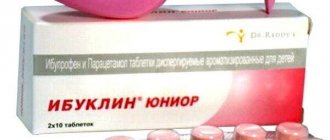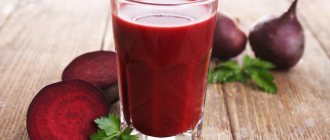What vitamins does a child over 1 year need?
As soon as the breastfeeding stage is completed, the baby is gradually transferred to regular food. This period occurs at the age of 1-2 years, when rapid growth and development begins. The formation of one's own immunity is observed. To help the child’s body, doctors advise giving vitamin and mineral complexes.
Children's vitamins from 1 year of age should include:
- Retinol. Responsible for the development of the optic nerve and skeletal growth. Vitamin A takes part in the formation of immunity and regulates the functionality of the intestinal tract. Helps the skin recover faster.
- B vitamins. Improve brain function, normalize the functionality of the nervous system, and improve sleep quality.
- Ascorbic acid. Increases immunity, strengthens vascular and venous walls.
- Vitamin D3. Essential for strong teeth and bones. Prevents the development of caries, normalizes the functioning of the cardiovascular system.
- Alpha tocopherol. Improves the functioning of the nervous and circulatory system, supports the immune system.
Children often refuse healthy food because it doesn’t seem tasty enough for them. Therefore, it is not possible to feed them fish, liver and eggs. But in order to avoid the development of vitamin deficiency, it is necessary to periodically give the baby vitamins that are sold in pharmacies.
Salt in children's diets
In the first days of their life, a child's diet consists only of mother's milk or infant formula, and therefore their taste buds are still very delicate. When introducing new products into a child’s diet, they have a bright and unusual taste for him, so adding salt will not improve the taste of the dish, but will only spoil it. It would also be unnecessary to use hot spices, which can burn the delicate mucous membranes in the child’s mouth. To supply the child’s body with minerals, the salt contained in the products themselves will be sufficient. Salt is present in bread and other flour products, hard cheese, and butter. It is better to replace salt in children’s diet with a small amount of lemon or cranberry juice, thanks to which, for example, the taste of soup or porridge will become brighter for the baby and at the same time it will become enriched with vitamin C, which is very useful. The introduction of salt into a child's diet should be carried out gradually at the age of one year so that the kidneys are not overloaded and so that this does not cause fluid retention in the body. Children are happy to eat dishes without salt and other seasonings, since they have not tried anything like it, and they do not have the opportunity to compare the new taste with something else.
Indications for taking vitamins
Fortified products are prescribed to children:
- with a poor diet;
- with increased physical and neuropsychic stress;
- with frequent colds;
- to improve immunity;
- after an illness;
- when the absorption of nutrients from food is impaired.
The complexes will be useful for those children who live in environmentally unfavorable conditions. The drugs are also indicated for children with clinical or antibacterial vitamin deficiency.
Parsley
Its main wealth is vitamins and minerals.
- Parsley is the standard for ascorbic acid content. She is fine with carotene and with B-group vitamins. And if we talk about mineral elements, parsley contains, perhaps, the entire part of the periodic table that is most useful for humans. So add it to your children's meals as often as possible.
- The whole plant is eaten as a whole, since minerals are concentrated in the roots and vitamins in the leaves.
- Parsley is used not only as a seasoning. You can make a wonderful filling from it and prepare, for example, delicious rolls.
How to choose vitamins for a child
Pharmacological companies offer vitamin complexes that are specifically designed for children.
They have their own characteristics, unlike dietary supplements for adults:
- The amount of active ingredients. There are many more of them in multivitamins for adults. Therefore, if you give them to a child, it will lead to vitamin deficiency.
- The presence of vitamin D3. Every child needs this microelement, because it takes part in the formation of bones and teeth. Medicines also include calcium so that vitamin D is absorbed better.
- Divided by age. All children's medications have restrictions. This is because as a child gets older, he or she needs more vitamins and minerals.
If parents decide to give their children dietary supplements, it is better to first consult a doctor. The range of drugs is large and each of them has its own characteristics. Self-administration may lead to overdose. This is as bad as a lack of nutrients.
When choosing vitamin-mineral complexes, you should consider:
- Country of origin. There are foreign and domestic funds that differ in cost.
- Release form. Pharmacological companies produce gummies, lollipops and lozenges. It is better to give children one year vitamins in the form of powder, drops and syrups.
- Availability of additives. It is better to choose dietary supplements that do not contain flavorings. These substances most often lead to allergies.
There are medications that need to be given once a day. Others require two or three times of application, which is not always convenient.
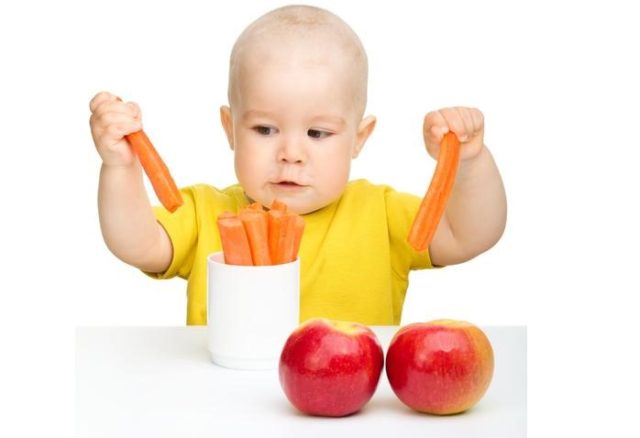
What is the best way to give it to a child?
If a mother decides to give parsley to her child, she needs to know that an allergy to parsley may occur. It is possible that an allergy to cilantro may also appear. First, they give the smallest portion and monitor the child’s condition. If there are no manifestations, then greens can be given to the child. Parsley and cilantro are usually given to children under one year of age as complementary foods in the form of puree and only after heat treatment. In order to exclude the possibility of bacterial infection, the greens must be thoroughly washed.
If you pre-soak the parsley for a couple of hours, you can get rid of the pesticides. It is better to purchase greens that were grown without the use of fertilizers. Despite the fact that fresh greens contain a sufficient amount of antioxidants, it is better to give parsley and cilantro to children under one year of age after heat treatment. To do this, the leaves can be thrown into boiling water for a few minutes. It is allowed to spray them with steam. Now almost every mother has a steamer in her kitchen.
Parsley and cilantro can be offered fresh to children under 1 year of age without heat treatment. But first it must be thoroughly washed and finely chopped. Parsley and cilantro for children aged 2 years can be offered in the form of a variety of salads. At this time, the children are already eating them. It is better if the salads are seasoned with olive oil. There will be even more benefits from this.
Since parsley has a somewhat bitter taste, feeding it to a child will not be so easy. Some children refuse to eat it. In this case, parents resort to various tricks, for example, adding greens to mashed potatoes. In this form, food is more pleasant for the baby.
Komarovsky's opinion on multivitamins for children
Komarovsky believes that it is necessary to buy multivitamins for children over 1 year of age if the child exhibits symptoms of vitamin deficiency in the form of:
- chronic fatigue, lethargy, apathy;
- drowsiness or, conversely, insomnia;
- peeling and dry skin;
- nervousness;
- bleeding gums;
- the appearance of cracks in the corners of the lips;
- formation of ulcers on the oral mucosa.
If we talk about prevention, the doctor claims that such a measure as taking vitamins will be unnecessary. Some of the nutrients enter the body through food. It is better to diversify your child’s diet with fruits, vegetables, meat, fish and porridge. In addition to all this, dietary supplements include various additives, which can also adversely affect the functionality of internal organs. Excess microelements can lead to the development of serious problems. And getting rid of it is more difficult than getting rid of vitamin deficiency.
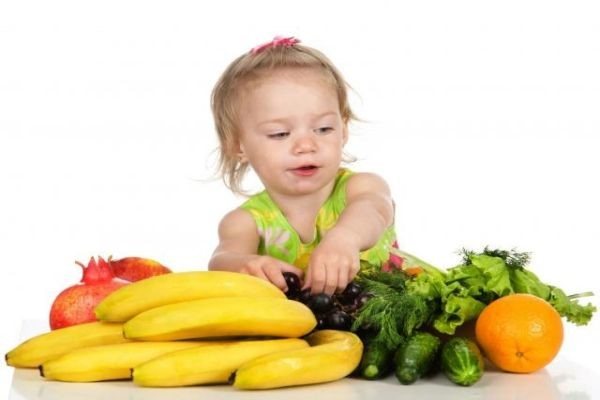
Attention! If the child really has problems, then it is advisable to consult a doctor and get tested. After which a decision will be made about taking multivitamins.
How to choose and store parsley for baby food
Parsley in baby food should always be fresh. When purchasing parsley, you should make sure that the leaves do not contain moisture, as moisture is a breeding ground for bacteria and mold. In markets, greens are often stored under the scorching sun and the greens are sprinkled with water to make them last longer, so you should take a closer look at grandmothers who sell greens in jars of water and sit under umbrellas; they are better suited for baby food. Parsley should be free of rotten, yellowed leaves, the leaves should be soft, not hard. The stiffness of the leaves indicates that the parsley is old, having been growing for more than a month.
For a child, it is better to take fresh young parsley leaves. The aroma of parsley should be bright, fresh, without impurities. If the seller allows, you can chew parsley; it should not give off nitrates. Recently, a large amount of greens grown with the help of chemicals has appeared, which allow you to harvest more often, but such greens spoil quickly, have a strange chemical taste and are not at all suitable for baby food.
Parsley can be stored in different ways. On the one hand, you can put it in a jar of water, cover the parsley itself with a bag on top and put it in the refrigerator in this form. You can store up to 7 days, changing the water constantly. Or rinse the parsley well, dry it and wrap it in parchment paper; it can be stored in this form for 3-7 days. Homemade parsley from the garden can be stored well in the bottom tray of the refrigerator in a regular bag for up to 3 weeks, if you periodically sort it out, dry it and get rid of rotten leaves. But it’s true that such parsley is not suitable for baby food; the risk of developing pathogens in it is too high. It is better to always use fresh parsley for children.
Parsley can be frozen , ice trays are suitable for this. Wash the parsley, dry it, chop it finely, put it in an ice tray, pour boiling water over it, and freeze. These cubes can be stored for up to 6 months. Perfect for soups, borscht, and main courses. Defrosting is easy, throw in a couple of cubes 2-3 minutes before the soup is ready. The main thing is to let the soup simmer for 1 minute, since uncooked greens can lead to sourness of the soup, tested from personal experience.
You can also dry parsley. But it must be dried in a dark place, otherwise the leaves will turn yellow and you won’t get beautiful greenery. We prepare parsley in the same way as when freezing it, wash it, dry it, cut it, and then lay it out on newspaper and dry it in a cool, dark place.
Disease Prevention
Avoiding problems is better than looking for ways to solve them. Simple rules will help prevent crop loss:
- Heat treat the seeds before planting (temperature +45-50°C).
- Collect and remove plant debris at the end of the season.
- Weed and loosen the beds. Apply potassium and phosphorus fertilizers for fertilizing.
- Sow the crop in drained, ventilated areas. Thin out plants.
You can grow parsley all year round, using a heated greenhouse or apartment window sill in winter. This process is simple and inexpensive, and there will always be a bouquet of vitamins on the table.
Author: Posol67
Moscow, Russia, on the website from 01/11/2017
Source
Reading time: 8 minutes. .2k.
The idea of growing parsley on a windowsill will be interesting to adults and children. The plant is relatively unpretentious; there are shade-tolerant varieties, and diseases are rare when grown indoors.
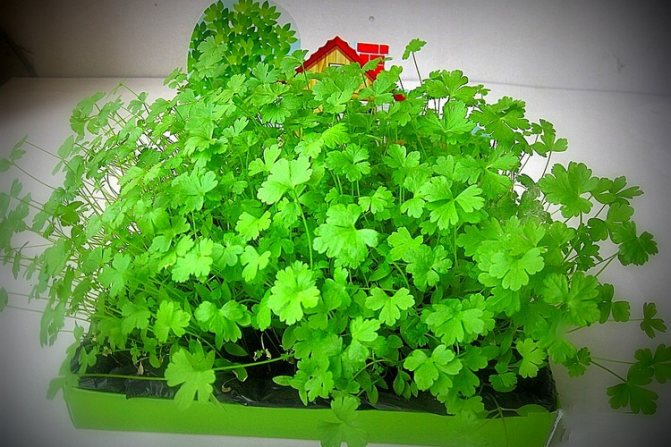
We'll tell you how to grow parsley at home, how best to plant it and in what soil. Let's talk about all aspects of cultivation, from watering to fertilizing.





